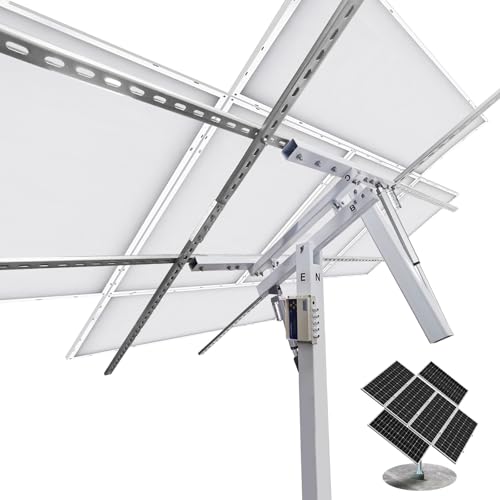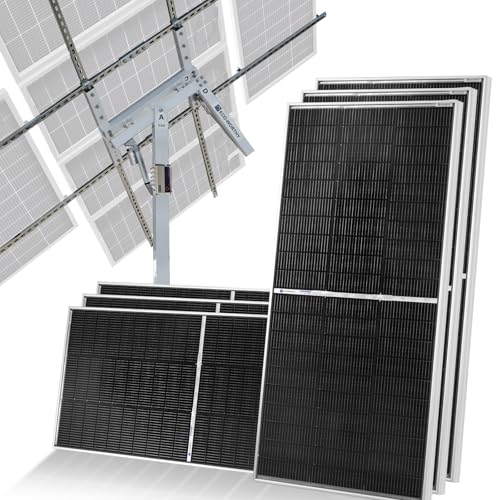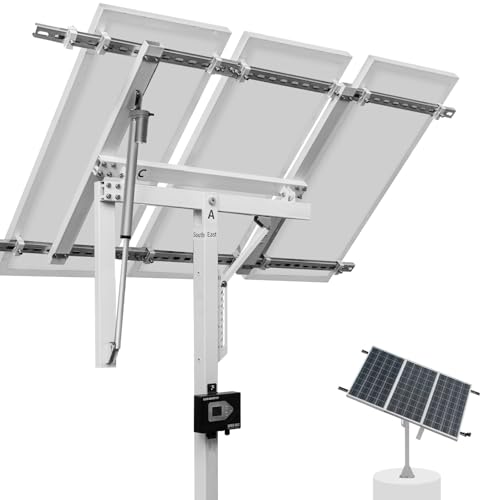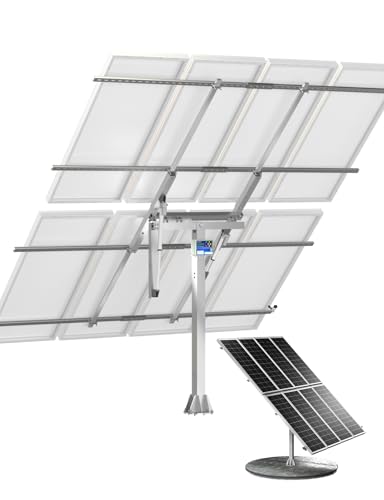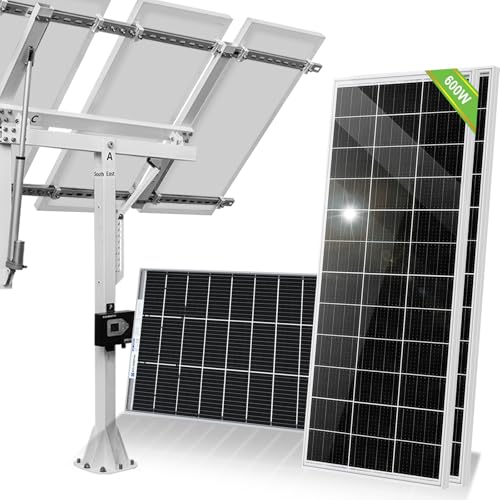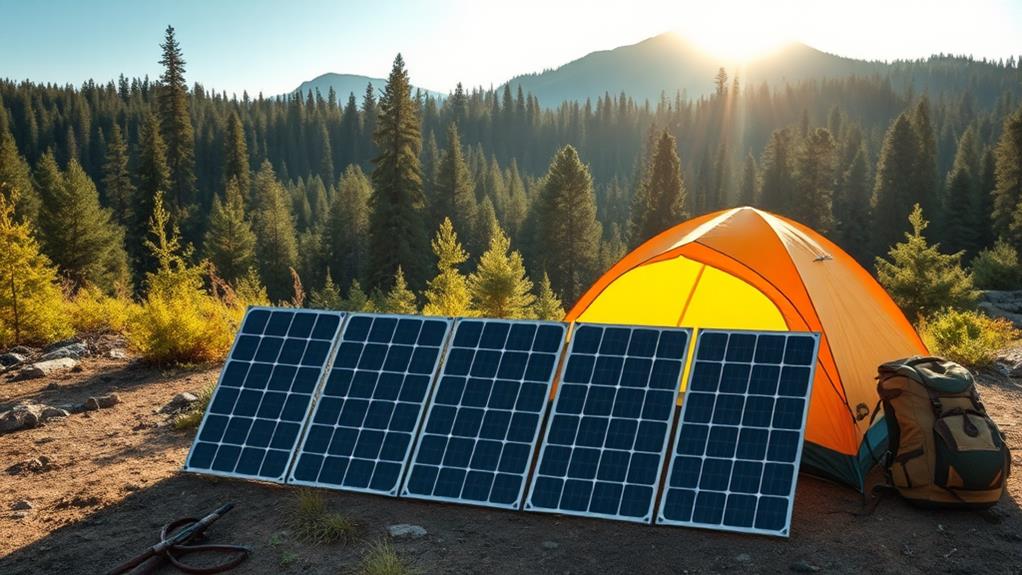In 2025, the top solar panel tracking systems for maximum energy efficiency include ECO-WORTHY’s dual-axis and single-axis models, offering up to 40% increased power generation over fixed installations. These systems feature advanced tracking capabilities, with 270° rotation for peak sunlight absorption, and are compatible with various panel configurations. High-performance options incorporate bifacial panels, wind sensors, and lithium battery storage. When selecting a system, consider factors such as tracking type, space requirements, weather resistance, and long-term cost-effectiveness. Proper evaluation of these elements will guarantee you maximize your solar investment’s potential, with some installations reporting yields exceeding 15.5 kWh/day under ideal conditions.
Key Takeaways
- Dual-axis tracking systems offer up to 40% increased energy production compared to fixed mounts, maximizing efficiency.
- ECO-WORTHY’s dual-axis tracker with 270° rotation optimizes sunlight absorption for six 195W panels.
- Single-axis trackers provide at least 30% more energy than fixed systems while requiring less space.
- Advanced weather sensors and automatic leveling mechanisms enhance performance in varying conditions.
- Consider installation space, initial costs, and long-term energy gains when selecting a solar tracking system.








ECO-WORTHY Solar Panel Dual Axis Tracking System
- [Generate more power] Dual-axis solar tracker make the mounted panels turn face to sunlight any daytime. Compared to fixed solar panels, the PV power...
- [270°Rotation] With 2 axis driving and sensitive sunshine sensor, the solar tracker can rotate for 270°, and make the panels to absorb the sun...
- [Steady in wind] There is a air speed sensor for windy days, when it detects heavy wind (data can be set manually), the solar tracker will auto reset...
Last update on 2025-12-08 / Affiliate links / Images from Amazon Product Advertising API
If you’re looking to maximize your solar energy production, the ECO-WORTHY Solar Panel Dual Axis Tracking System is a top contender. This system boosts power generation by at least 40% compared to fixed panels, featuring 270° rotation for ideal sunlight absorption. Designed for six 195W panels, it requires a 114.2in x 114.2in ground space and stands 3.93ft tall, making it suitable for yards, farms, and flat roofs. The tracker’s performance is impressive, with users reporting over 15.5 kWh/day production. Its dual-axis design allows consistent energy capture throughout the day, outperforming fixed installations. While assembly can be challenging due to unclear instructions, recent models have improved, and customer service is responsive to missing parts issues. The system’s robust base and wind speed sensor guarantee stability, even in high winds.
Best For: Solar energy enthusiasts and property owners looking to maximize power generation from solar panels in various settings like yards, farms, and flat roofs.
Pros:
- Increases power generation by at least 40% compared to fixed solar panels
- Dual-axis tracking with 270° rotation optimizes sunlight absorption throughout the day
- Includes a wind speed sensor for automatic angle adjustment during heavy winds
Cons:
- Assembly can be challenging due to unclear instructions
- Requires a significant amount of ground space (114.2in x 114.2in)
- Some users reported missing parts upon delivery
ECO-WORTHY 1200W Solar Tracker System with Bifacial Panels and Dual-Axis Tracking
- 【More Daily Output】 Starting from Nov 3, 2025, due to tech iteration, the tracking system is fully equipped with 195W N-type panels, taking the...
- 【Tracker Bracket】Equipped with a sensitive sunshine sensor and 2-axis driving system, the solar tracker can rotate up to 270°, allowing the...
- 【Quick Ways to Get After-Sales Support】For any product issues or concerns, please contact us through your order details to ensure we can provide...
Last update on 2025-12-08 / Affiliate links / Images from Amazon Product Advertising API
For those seeking a high-performance off-grid solar solution, the ECO-WORTHY 1200W Solar Tracker System stands out with its dual-axis tracking and bifacial panels. This system, comprising six 195W monocrystalline panels and a sophisticated tracking kit, offers an impressive daily output of 5.2KWh under ideal conditions. The dual-axis tracker, featuring a sensitive sunshine sensor, rotates up to 270°, enhancing sunlight capture by approximately 40% compared to fixed installations. With high-efficiency panels measuring 59.2*28.3*2.2 inches, the system is designed for durability, utilizing corrosion-resistant aluminum frames. Installation requires a ground space of 111in * 106in and a height of 3.93ft, making it suitable for various off-grid applications such as sheds, farms, and remote locations. While customer ratings average 3.8 out of 5 stars, the system’s performance specifications suggest significant potential for maximizing solar energy production.
Best For: This system is best for off-grid enthusiasts and property owners seeking a high-efficiency solar solution for remote locations like farms, sheds, or large outdoor areas with ample ground space.
Pros:
- Dual-axis tracking system increases sunlight capture by 40% compared to fixed installations
- High daily output of 5.2KWh under ideal conditions
- Durable design with corrosion-resistant aluminum frames for longevity
Cons:
- Requires significant ground space for installation (111in * 106in)
- Average customer rating of 3.8 out of 5 stars suggests potential issues or limitations
- May be complex to install and maintain for those unfamiliar with solar tracking systems
ECO-WORTHY Solar Panel Single Axis Tracking System with Controller
- 【Quick Ways to Get After-Sales Support】For any product issues or concerns, please contact us through your order details to ensure we can provide...
- 【More power generation】Single-axis tracking mounts maximize efficiency by keeping your solar panels facing the sun at all times. Single-axis...
- 【For different panels】The single-axis tracking racking system is also suitable for different sizes of solar panels.Up to 4 panels can be installed...
Last update on 2025-12-08 / Affiliate links / Images from Amazon Product Advertising API
Solar enthusiasts seeking a substantial boost in power generation will find the ECO-WORTHY Solar Panel Single Axis Tracking System an excellent choice. This system greatly enhances efficiency by maintaining ideal panel alignment with the sun, resulting in a minimum 30% increase in power output compared to fixed mounts. Utilizing light sensors and controllers, the system adjusts panels through 270° of angular movement, maximizing solar energy absorption throughout the day.
The tracking system’s versatility accommodates various panel sizes, supporting up to 4 panels (width < 22 in), 3 panels (width < 29.5 in), or 2 panels (width < 44.8 in). Installation is straightforward, requiring only four steps: base securing, rod and actuator connection, controller installation, and panel attachment. With wind resistance exceeding L8 and pressure resistance over 5400PA, the system guarantees durability in diverse environmental conditions. Users report ease of setup, clear instructions, and effective tracking performance, with a user-friendly controller for switching between tracking and flat bracket modes.
Best For: Solar energy enthusiasts and homeowners looking to significantly increase their solar power generation efficiency with an easy-to-install and durable tracking system.
Pros:
- Increases power generation by at least 30% compared to fixed mounts
- Versatile compatibility with various solar panel sizes
- Easy installation process with clear instructions and pre-packaged components
Cons:
- Initial concerns about availability of replacement parts
- May require direct contact with Eco-Worthy for customer support
- Limited to single-axis tracking, which may not be optimal for all locations
ECO-WORTHY Solar Panel Dual Axis Tracking System with Controller
- Intelligent detection of strong light by high-precision light sensor, power generation efficiency increased by 40%: The tracker equipped with light...
- Capture every beam of light and increase effective light time: The solar tracker combines dual-axis drive and sensitive sensors to realize 270°...
- Automatic leveling in high winds to withstand extreme weather: When the wind speed exceeds 17.2m/s (0.0107mile/s), it can be automatically leveled...
Last update on 2025-12-08 / Affiliate links / Images from Amazon Product Advertising API
Homeowners with limited space will appreciate the ECO-WORTHY Solar Panel Dual Axis Tracking System‘s efficiency. This expanded version boosts power generation by 40%, compatible with various panel configurations: 10x 100W, 8x 200W, or 4x 400W. The system’s high-precision light sensor intelligently detects sunlight intensity, while its dual-axis drive enables 270° accurate sun tracking, optimizing panel orientation and extending effective light time. In adverse weather, the tracker automatically levels when wind speeds exceed 17.2 m/s (0.0107 mile/s), with manual adjustment for snow removal. Occupying only 0.0484 m², it saves 90% installation space compared to traditional brackets, making it ideal for small yards or farms. ECO-WORTHY offers dedicated one-on-one customer service and lifelong technical support, ensuring assistance for any questions or issues that may arise.
Best For: Homeowners with limited space who want to maximize solar energy production and efficiency.
Pros:
- Increases power generation efficiency by 40% through dual-axis tracking
- Weather-resilient design with automatic leveling in high winds
- Space-efficient installation, saving 90% compared to traditional brackets
Cons:
- May require professional installation due to complexity
- Higher initial cost compared to fixed solar panel systems
- Manual adjustment needed for snow removal in winter conditions
ECO-WORTHY 1200W Solar Tracker System with Lithium Battery
No products found.
Off-grid enthusiasts seeking a complete solar solution will find the ECO-WORTHY 1200W Solar Tracker System with Lithium Battery an ideal choice. This all-encompassing package includes six 195W bifacial solar panels, a dual-axis tracking kit with controller, and two 12.8V 280Ah LiFePO4 batteries. The system’s daily power generation capacity of 7.2KWh, coupled with a 7.16KWh storage capacity, guarantees ample energy for various AC appliances. The solar panels, featuring 12BB cells and 91.5% light transmittance, boast a 23% conversion rate and enhanced durability. The dual-axis tracking system, rotating 270° with 50° adjustments, increases energy capture by approximately 40% compared to fixed mounts. The lithium batteries, equipped with a robust BMS, support over 6000 deep cycles and offer superior safety and versatility over lead-acid alternatives.
Best For: Off-grid homeowners, farmers, and remote cabin dwellers seeking a comprehensive, high-efficiency solar power system with advanced tracking and storage capabilities.
Pros:
- High daily power generation (7.2KWh) and storage capacity (7.16KWh) suitable for powering multiple AC appliances
- Dual-axis tracking system increases energy capture by approximately 40% compared to fixed mounts
- LiFePO4 batteries with advanced BMS offer superior safety, longevity, and versatility over traditional lead-acid batteries
Cons:
- High initial investment cost due to advanced technology and comprehensive system components
- Complex installation process may require professional assistance
- Large physical footprint needed for six solar panels and tracking system, which may not be suitable for all locations
ECO-WORTHY 600W Solar Panel Tracker System with Bifacial Panels
- [Why Choose Tracking Racking System]:Single-axis tracking racking maximizes efficiency by keeping solar panels facing the sun at all times. Combined...
- [Daily Output]: The 600W solar tracking kit's ideal daily output power is about 3.6KWh per day (under 4 hours full sunlight). Suitable for home, farm,...
- [Solar Panels]: The high-efficiency monocrystalline solar panels have a compact design with dimensions of 59.2*28.3*2.2 inches. Its aluminum frame has...
Last update on 2025-12-08 / Affiliate links / Images from Amazon Product Advertising API
For those seeking to maximize solar energy production in off-grid settings, the ECO-WORTHY 600W Solar Panel Tracker System with Bifacial Panels offers an impressive solution. This system combines three 195W monocrystalline bifacial panels with a single-axis tracking kit, designed to increase power generation by at least 30% compared to fixed mounts. The tracking system utilizes light sensors and controllers for 270° angular adjustment, ensuring peak energy absorption throughout the day.
You’ll benefit from the system’s corrosion-resistant aluminum frame and easy installation process, with pre-set controllers and pre-connected wires. The setup requires a ground space of 111in x 106in and stands 3.93ft tall, making it suitable for various off-grid applications. Under ideal conditions of 4 hours of full sunlight, you can expect a daily output of approximately 3.6KWh, providing ample power for sheds, farms, and cabins.
Best For: This system is best for off-grid property owners looking to maximize solar energy production in spaces like yards, farms, fields, or flat roofs.
Pros:
- Increases power generation by at least 30% compared to fixed mounts
- Easy installation with pre-set controller and pre-connected wires
- Durable construction with corrosion-resistant aluminum frame
Cons:
- Requires a significant amount of ground space (111in x 106in)
- May not be suitable for all roof types or urban settings
- Higher initial cost compared to fixed solar panel systems
Factors to Consider When Choosing a Solar Panel Tracking System

When selecting a solar panel tracking system, you’ll need to take into account several essential factors that can greatly influence your system’s performance and longevity. These factors include the tracking type (single-axis or dual-axis), performance and efficiency improvements, installation requirements and compatibility with existing infrastructure, weather resistance capabilities, and the overall cost and maintenance needs. By carefully evaluating these aspects, you can make an informed decision that maximizes your solar energy production while ensuring a reliable and cost-effective solution for your specific requirements.
Tracking Type
One of the most critical factors to take into account when choosing a solar panel tracking system is the tracking type. You’ll primarily encounter two categories: single-axis and dual-axis systems. Single-axis trackers enhance power generation efficiency by aligning panels with the sun’s east-to-west movement, resulting in at least a 30% increase in energy production compared to stationary installations. However, if you’re aiming for ideal sunlight absorption from all directions, dual-axis systems provide superior performance with 270° rotation capabilities, potentially increasing energy capture by approximately 40% compared to fixed mounts.
When selecting between these options, you’ll need to evaluate your specific energy requirements, available space, and installation complexity. Dual-axis trackers, which allow for adjustment in both vertical and horizontal planes, are particularly advantageous in locations with varying sun angles throughout the year. For enhanced performance, you might opt for systems equipped with advanced tracking technology, such as sensitive light sensors. These can automatically adjust panel positioning to maximize sunlight exposure, even in fluctuating weather conditions, ensuring ideal energy harvesting throughout the day.
Performance and Efficiency
Performance and efficiency are essential factors to take into account when selecting a solar panel tracking system. When examining options, consider that tracking systems can considerably increase energy generation by 30% to 40% compared to fixed mounts. This improvement stems from the system’s ability to enhance sunlight absorption throughout the day, with dual-axis trackers offering rotation up to 270°, effectively capturing sunlight from various directions.
To maximize efficiency, opt for high-performance monocrystalline solar panels, which typically boast conversion rates of around 23%. These panels, when paired with tracking systems, can greatly boost daily power output. Some installations have reported yields exceeding 15.5 kWh/day from multiple panels under ideal conditions. For even greater energy capture, consider incorporating bifacial solar panels into your tracking system. These panels feature transparent backs, allowing light absorption from both sides, further enhancing overall efficiency. When evaluating tracking system performance, evaluate the potential energy gains against your specific geographical location, local climate conditions, and energy requirements to determine the most suitable configuration for your installation.
Installation and Compatibility
Frequently overlooked, installation and compatibility are vital factors to analyze when choosing a solar panel tracking system. When evaluating your options, consider the available ground space, as dual-axis systems typically require approximately 114in x 114in, while single-axis systems need about 111in x 106in for installation. It’s essential to confirm compatibility with your existing solar panels, as some tracking systems can accommodate various sizes, supporting up to four panels with widths less than 22 inches or two panels with widths less than 44.8 inches.
Examine the height of the tracking system, with most dual-axis models standing at around 3.93ft, suitable for diverse installations including yards and flat roofs. Check the installation complexity; while some systems offer clear instructions and pre-packaged components, others may necessitate additional guidance through online resources. Evaluate the durability and weather resistance of the tracking system, as high winds and snow loads can affect performance. Look for systems with wind resistance ratings exceeding 5400PA to guarantee peak functionality in challenging weather conditions. By carefully considering these factors, you’ll be better equipped to select a solar panel tracking system that seamlessly integrates with your existing setup and maximizes energy production.
Weather Resistance
When the skies darken and winds howl, your solar panel tracking system faces its ultimate test. To guarantee peak performance in adverse conditions, you’ll need to take into account several vital factors. First, prioritize wind resistance capabilities, selecting systems designed to withstand wind speeds exceeding 17.2 m/s (38 mph). This guarantees stability during harsh weather events, maintaining energy production when you need it most. Look for systems equipped with automatic leveling mechanisms, which adjust panel angles to maximize energy absorption even in high winds.
In regions prone to heavy snowfall, durability against snow loads is paramount. Choose systems capable of supporting snow pressures over 5400Pa to prevent damage and maintain functionality throughout winter months. Corrosion-resistant materials are essential for long-term durability, protecting your investment from environmental degradation over time. For peak performance in varying weather conditions, evaluate systems with advanced weather sensors. These intelligent systems can automatically adjust panel angles based on real-time data, enhancing energy capture during adverse weather. By carefully assessing these weather resistance factors, you’ll guarantee your solar panel tracking system remains efficient and reliable, regardless of Mother Nature’s whims.
Cost and Maintenance
While weather resistance guarantees your solar panel tracking system‘s durability, you’ll also need to weigh the financial aspects of your investment. Consider the initial cost versus the potential 40% increase in energy production that dual-axis systems can offer compared to fixed mounts. This substantial boost in efficiency can offset higher upfront expenses over time. When evaluating tracking systems, factor in the additional components, such as controllers and sensors, which may increase initial costs but enhance overall performance and functionality.
Maintenance is an essential consideration in your cost analysis. While tracking systems may require periodic adjustments and checks, they typically have lower long-term operational costs due to their increased efficiency and output. To maximize cost-effectiveness, invest in robust, durable materials that can withstand environmental stressors, reducing the need for frequent repairs or replacements. Implement a regular maintenance schedule, including cleaning sensors and ensuring proper alignment, to maintain peak efficiency and extend the system’s lifespan. By carefully balancing these factors – initial investment, potential energy gains, component quality, and ongoing maintenance – you’ll be able to select a solar panel tracking system that offers the best long-term value for your specific needs.
Frequently Asked Questions
How Do Solar Tracking Systems Perform in Extreme Weather Conditions?
Imagine a ship steering through stormy seas; solar tracking systems face similar challenges in extreme weather. You’ll find they’re engineered to withstand harsh conditions, with robust designs that can endure high winds, heavy snow loads, and extreme temperatures. Many systems incorporate safety features like stow positions to protect panels during storms. However, performance may be impacted during severe weather events, as tracking accuracy can be affected by factors such as cloud cover, wind gusts, or accumulation of snow and ice on sensors.
What Maintenance Is Required for Solar Panel Tracking Systems?
You’ll need to perform regular maintenance on your solar panel tracking systems to guarantee peak performance. This includes lubricating moving parts, tightening bolts, and cleaning sensors every 6-12 months. You should also inspect the motors, gears, and control systems annually, replacing worn components as needed. It’s essential to check the tracking accuracy periodically and recalibrate if necessary. Additionally, you’ll want to clean the panels themselves, as dirt accumulation can reduce efficiency by up to 25%.
Can Tracking Systems Be Retrofitted to Existing Solar Panel Installations?
Like a phoenix rising from the ashes, you can breathe new life into your existing solar panel installation with retrofitted tracking systems. You’ll need to assess your current setup‘s compatibility, considering factors such as structural integrity, available space, and existing wiring. Retrofitting often involves installing actuators, sensors, and a control system. While it’s technically feasible, it’s essential to evaluate the cost-benefit ratio, as the increased energy yield must justify the investment in equipment, installation, and ongoing maintenance. Consult with a solar professional for a site-specific assessment.
How Much Additional Energy Do Tracking Systems Typically Generate Compared to Fixed Panels?
You’ll typically see a significant increase in energy production with tracking systems compared to fixed panels. Single-axis trackers can boost output by 25-35%, while dual-axis systems may achieve 35-45% gains. However, these figures vary based on factors like latitude, climate, and local shading conditions. It’s essential to recognize that the actual benefit can fluctuate seasonally, with greater advantages during summer months when days are longer and solar irradiance is higher.
Are There Any Zoning or Permit Restrictions for Installing Solar Tracking Systems?
You’ll often encounter zoning and permit restrictions when installing solar tracking systems. These regulations vary by location, but typically address height limitations, setback requirements, and visual impact. You may need to obtain special use permits, comply with structural engineering standards, and meet electrical code requirements. Some jurisdictions restrict tracking systems in residential areas or require screening measures. It’s essential to consult local building departments, review zoning ordinances, and potentially engage with a solar installation professional to navigate these regulations effectively.

